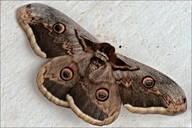|
|
click photo for larger file

Saturnia pyri
Giant Peacock Moth
|
Photographer: Dr. Amadej Trnkoczy
ID: 0000 0000 0722 0773 (2022-07-09)Copyright © 2022 Dr. Amadej Trnkoczy
|
|
INFORMATION PROVIDED WITH THE PHOTO
|
date of photo May 10, 2022
latitude 44.80378 longitude 14.36944
View on Google Maps.
location
Adriatic Sea, island Cres, settlement Miholašćica, Kvarner bay (Rijeka region, Croatia)family
Saturniidae
order
Lepidoptera
class Insecta
notes Slo.: veliki nočni pavlinček, veliki pavlinec - Habitat: Village garden; calcareous bedrock, dry, sunny place, average precipitations ~ 1.000 mm/year, average temperature 13-15 deg C, elevation 20 m (66 feet), Sub-Mediterranean phytogeographical region. - Comment: The butterfly Saturnia pyri is attractive because it is among the largest in this part of the world. It can have up to 13 cm across the wings. But it is mostly in brown and gray shades. No vivid colors are displayed as in so many other butterflies. They would be anyhow meaningless since this species is a night butterfly. - Its rather hard to take good pictures of it in the wild. First, it is a night butterfly and light conditions are regularly difficult and second, it is rather nervous, always in motion, species. - Contrary to this, caterpillars are very colorful. So many caterpillars are beautifully colored, but probably no one reaches the Saturnia pyri. It is also among the largest one and can be up to 12 cm long and massive – quite a 'beast'! The caterpillar changes its color during its growth; at the beginning it is almost black, then green, then yellowish and before the pupation orange tinted. Most bizarre are its thorny glands and hairs. It feeds mostly on leaves of fruit trees but also of Juglans regia, Fagus sylvatica and Corylus avellana and other broadleaved trees. It can be found most often in orchards. Unfortunately, spraying pesticides means death. Also large, old fruit trees traditionally grown around farmhouses are becoming rarer and rarer today. Hence it is already a rare and highly endangered species and protected in many countries including Slovenia. - Enlisted in the Slovene Red List of rare and endangered species, marked by 'V' representing a vulnerable species. - Ref.: (1) Fauna Europas, Bestimmungslexikon, George Westermann Velag, Brounschweig (1997), translated to Slovenian, Mladinaka Knjiga, Ljubljana (1981), p 400. (2) http://www.pyrgus.de/Saturnia_pyri_en.html (accessed Feb.12. 2021)camera Nikon D700 / Nikkor Micro 105mm/f2.8
contributor's ID # Bot_1461/2022_DSC7724 photo category: Animal - Invertebrate-Insect
|
MORE INFORMATION ABOUT THIS ANIMAL
|
| common names
Giant Peacock Moth, Great Peacock Moth, Giant Emperor Moth (photographer)
View all photos in CalPhotos of Saturnia pyri Check Google Images for Saturnia pyri |
|
The photographer's identification Saturnia pyri has not been reviewed. Click here to review or comment on the identification. |
|
Using this photo The thumbnail photo (128x192 pixels) on this page may be freely used for personal or academic purposes without prior permission under the Fair Use provisions of US copyright law as long as the photo is clearly credited with © 2022 Dr. Amadej Trnkoczy.
For other uses, or if you have questions, contact Dr. Amadej Trnkoczy amadej.trnkoczy[AT]siol.net. (Replace the [AT] with the @ symbol before sending an email.) |
|
|
